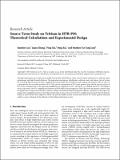Source Term Study on Tritium in HTR-PM: Theoretical Calculations and Experimental Design
Author(s)
Cao, Jianzhu; Zhang, Liguo; Xie, Feng; Xia, Bing; Lam, Stephen Tsz Tang
DownloadSTNI.2017.3586723.pdf (1003.Kb)
PUBLISHER_CC
Publisher with Creative Commons License
Creative Commons Attribution
Terms of use
Metadata
Show full item recordAbstract
The high temperature gas-cooled reactor pebble-bed module (HTR-PM) in China received much attention for its inherent safety performance and high thermal efficiency. The generation mechanism, distribution, reduction route, and release type of tritium (H-3) in HTR-PM are presented with a complete theoretical model. The calculation results indicate the majority of H-3 in the core is generated by the activation reaction of B-10. The activity concentration of H-3 in the primary loop and the specific activity of H-3 in the secondary loop at the operating equilibrium are computed as 3.69 × 106 of helium and 4.22 × 104 Bq/kg of water, respectively. The H-3 sampling measurement in HTR-PM has been designed to collect data from the primary coolant, from the liquid waste storage tank, from the secondary coolant, and from the liquid and gaseous effluents, separately. In this paper, the design of H-3 sampling positions in the helium purification system is discussed. The H-3 sampling measurement from the primary helium in HTR-PM has been improved, which can provide reliable activity concentration data of H-3 in the primary loop and supply accurate evaluation for the efficiency of the helium purification system.
Date issued
2017-07Department
Massachusetts Institute of Technology. Laboratory for Nuclear ScienceJournal
Science and Technology of Nuclear Installations
Publisher
Hindawi Publishing Corporation
Citation
Cao, Jianzhu et al. "Source Term Study on Tritium in HTR-PM: Theoretical Calculations and Experimental Design." Science and Technology of Nuclear Installations (July 2017) © 2017 Jianzhu Cao et al
Version: Final published version
ISSN
1687-6075
1687-6083